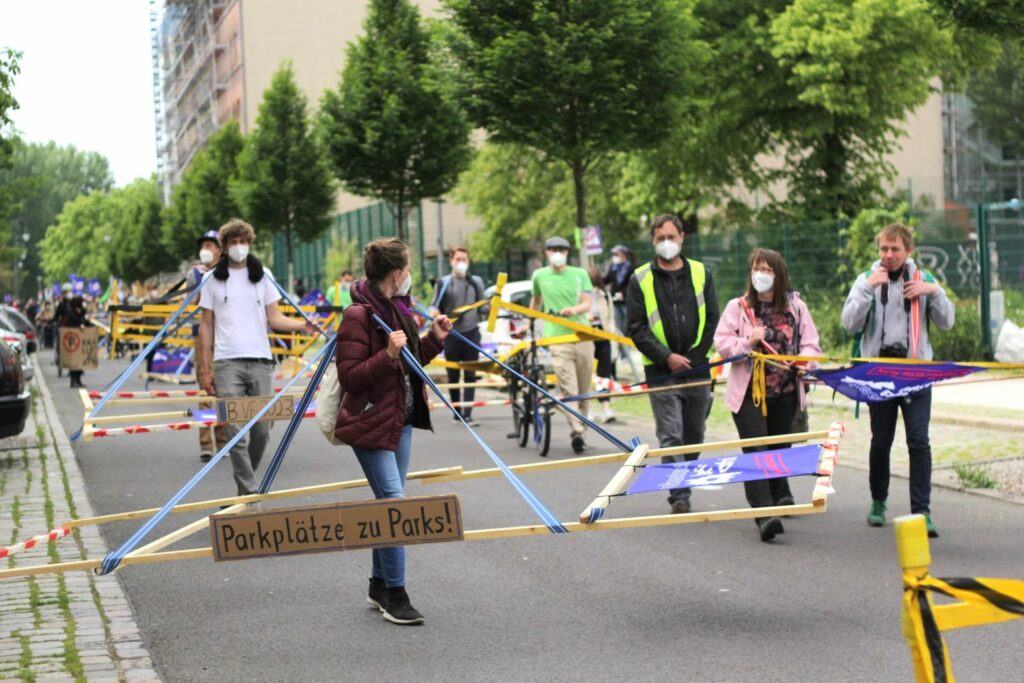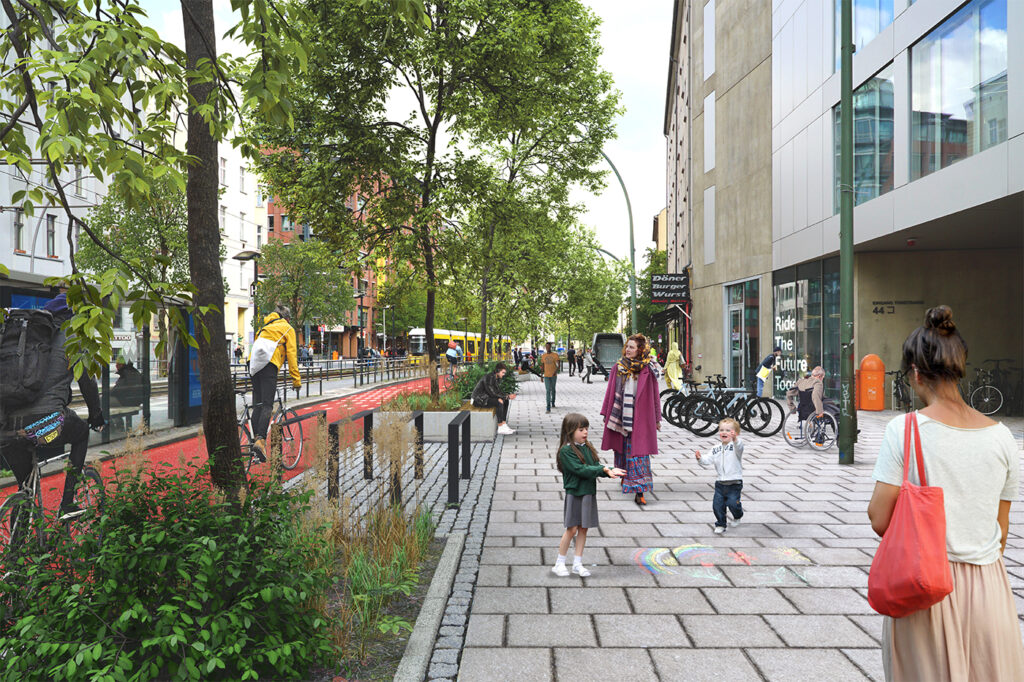A group of activists in the German capital are pushing an ambitious plan to eliminate private vehicles in the city center, an area twice as big as Manhattan.
The European Union’s largest economy has a long history with das auto, for better and worse. Many foreign tourists in Germany have a speed-limit-free trip on the autobahn among their bucket list items, but even among Germans, car culture is strong. The home of the Porsche, Audi, and BMW was also the birthplace of the Volkswagen—the “people’s car” for average Germans, which was first introduced in 1937 by then-chancellor Adolf Hitler.
Today, Germany has one of the world’s highest rates of car ownership: 574 vehicles per 1,000 residents. It’s all the more notable, then, that a Berlin-based citizens group organizing to fight climate change was able to submit more than 50,000 signatures in late 2021 in favor of virtually eliminating private automobile use in a 55-square-mile area of the city center.
The area lies inside the city’s Ringbahn, a circumferential rail line shaped roughly like a dog’s head that envelopes much of Berlin’s urban population. The 23-mile loop runs through multiple districts of Berlin, while the area inside the route comprises a dense urban environment more than twice the size of the island of Manhattan.
This makes the advocacy group’s move to ban the majority of private car trips inside the Ringbahn one of the most aggressive climate actions in the world. It comes none too soon, according to Thomas Howie, a member of the group, which is named Volksentscheid Berlin Autofrei (“People’s Decision for Auto-Free Berlin”) movement, or just Autofrei for shorthand. The group has around 150 members.
Even though Berlin isn’t near a rising ocean, Howie says, climate change has other effects in the city, including droughts and a corresponding lowering of the water table.
“Although Berlin and Brandenburg seem like they are covered in water [as the area has many lakes], you can already observe the effects of the lowered water table; many trees are dying in our city,” he wrote via email.
“Of course, this might not seem that drastic in the short term; however, it is highly likely that water prices will climb significantly in the medium term. This will impact all of us,” he adds. “More worryingly, extreme heating events, such as the 2003 heat wave, which killed thousands in Paris, will happen more often.”
Recent studies have also shown that land subsidence, in which formerly stable land sinks unexpectedly, is likely to increase in inland areas due to climate change.
There would be limits to the proposed Berlin car ban. Rental vehicles would still largely be allowed in the city’s core, and people with disabilities who needed private vehicle travel would get waivers, as would tradespeople.
But limits aside, the Autofrei advocacy team has made significant progress in building on a coalition of environmental groups that have been growing their collective support base for decades. Those include hiking and forestry clubs dating from the Cold War era, the Passivhaus initiative that started in West Germany in the 1970s, and members of religious groups, along with cycling advocates, railfans, and aging former attendees of the Ökoseminar (“eco-seminar”) meetings held semi-illicitly in a Prenzlauer Berg church’s secret environmental library during the waning days of socialist East Germany.
The ecological groundswell came to a head in 2021 with the rise of a national Green Party candidate for the chancellorship, Annalena Baerbock, who at first surged in the polls before a blend of embarrassing revelations and foreign interference took her largely out of contention in September’s federal elections, in which the Green Party placed third. Baerbock has since joined the national governing coalition of the Social Democrats, the Greens, and the Free Democrats as Germany’s new foreign minister.
Despite the electoral setback, both the Autofrei movement and a robust anti-freeway construction group are increasingly active within the city’s borders.
The Autofrei organization started as a group of about 15 people, many of whom had already been active in other pro-pedestrian advocacy, says Lisa Buchmann, another member of the group’s press team.
“Our volunteers and group members come from all over Berlin, including areas outside the S-bahn ring,” Buchmann says. “Because of this, digital meetings and other online tools turned out to be the most efficient and most accessible way to organize ourselves. We used mailing lists a lot in the beginning, but by now, most of our daily communication and exchange takes place via Slack.”
Buchmann says the organization, which seeks to challenge “the lack of imagination of people” regarding the cityscape, is relatively decentralized, with funding coming largely from small-euro donations, and with each working group having its own tools and communications channels. “They are pretty self-organized.”
Autofrei is not the first car-free movement in the world, and many efforts, such as those in the city of London, have gained steam during the pandemic. Other efforts, however, haven’t fared so well.
The citizens of Madrid, for example, tried to implement car restrictions in their city center, but the plan quickly became a political football. It was implemented in 2018, only to be rolled back in 2019 by a newly elected conservative city government—which soon found that the people actually rather liked the ban, with residents pushing back against the ripping out of pedestrian infrastructure. So Madrid’s restrictions were reinstated, only to then be struck down by Spain’s supreme court in May.

Pictures of a demo with so called “Gehzeuge” Initiative Volksentscheid Berlin autofrei / CC by-sa 4.0
Ideas to Poach
Other European cities have been more successful in implementing pedestrianization measures, giving inspiration to rivals. The grandfather of them all may be Groningen, Netherlands, where the population of about 230,000 spends more time on bicycles than in cars, according to The Guardian, and breathes the cleanest air of any Dutch city, according to a ranking by the European Environment Agency.
Groningen’s odyssey started in the mid-1970s, when a young, newly educated urban reformer named Max van den Berg got a rare carte blanche opportunity to reverse the popular design trend at the time of tearing down buildings to build freeways through cities. Instead, van den Berg took the opposite approach: He divided the city into quadrants and forced all nonlocal traffic to go around on a ring road in order to get from one quadrant to another, making cycling the most attractive way to travel through the center.
Germany has its own share of the pedestrianization landscape. Among the leaders is Heidelberg, a south Germany university city of around 160,000 that is coming along with its own car-free plans, with the mayor telling the The New York Times that if citizens need a car, they should “use car sharing … if you can’t use car sharing because you’re living too far outside and there is no mass transportation, then use the car, but just to the train station and not to downtown.”
Citizens in Heidelberg who give up their cars are allowed to ride public transit for one year free of charge. And the city’s pedestrian zone is approximately a mile across, Germany’s longest.
Larger European cities have also had luck in pushing a focus on transit, bicycles, and pedestrians, with London eyeing additional pedestrianization in the near future, and Paris committing to build 180 kilometers of new segregated bike lanes by 2026, according to Bloomberg CityLab. And cities such as Barcelona have taken the Groningen approach of reducing through-traffic in city centers, creating superblocks to encourage walking, cycling, and transit.
The most successful competitor in the race to be free of private autos may be Oslo, Norway, which recently took the relatively inexpensive approach of removing virtually all on-street parking from its city center.
That move was nearly as effective in getting rid of cars as an outright ban, according to a 2019 article in Fast Company, with pedestrian activity in the city center jumping 10% in the year after the parking places were converted to cycle lanes, miniature parks, and other uses.
But none of those plans comes close to the scope of Berlin’s possible future, which includes not only the Autofrei zone, but also a series of grade-separated bike highways, the revival of a tram network that was ripped out of West Berlin during the Cold War, and even the possible buildout of the long-abandoned U10 subway project.
This planning in the EU’s largest city comes in addition to what Berlin Senate spokesperson Jan Thomsen calls a “brilliant” public transport system that already offers S-bahn (fast urban railway), U-bahn (underground subway), Straßenbahn (the tram lines in former East Berlin) and bus service, alongside car-sharing, electric scooter, and bike-sharing programs. Thomsen says the city government does not officially support the proposed ban, with many staffers viewing it as an overly bureaucratic solution.
Cities in the U.S. often face steeper obstacles to enacting car-free zones, especially because many American cities don’t have expansive transit networks. Some activists have instead worked through zoning laws to allow denser development in areas that surround already dense downtowns, making car ownership less necessary.
The activist group 1000 Friends of Oregon had a big role in lobbying for the state to enact a law in 2019 to ban single-family housing zones, which would allow denser development in areas surrounding denser city centers in coming years. California followed suit in September 2021.
While most American cities aren’t quite ready for full car bans, activists can prepare the way by doing things like organizing block-long neighborhood festivals that shut down streets temporarily, says 1000 Friends’ deputy director, Mary Kyle McCurdy.
Such events can better demonstrate what small car-free areas might look like in the future, and the disruptions brought about by the pandemic have provided some leeway for experimentation.
“COVID has certainly increased” the banning of cars on individual streets, she says. “It’s a step toward realizing that we need to make our streets safer for all users, not just for cars.”

Renderings of busy streets in Berlin showing our vision of a carfree Berlin. Initiative Volksentscheid Berlin autofrei / CC by-sa 4.0
What Comes Next
The Berlin Senate, the city’s governing body, now has until the beginning of January 2022 to examine the text of the proposed car ban law and either pass or reject it.
If the law were to be rejected by the Senate, the advocacy group would then enter a second round of signature gathering, with 175,000 valid support signatures needed to put the measure on the 2023 ballot. If passed, the law would take effect in 2027, Howie says.
The ballot measure has a better chance in the capital than if it were introduced in other parts of Germany. Thanks partially to a strong transit system, Berlin has the lowest car ownership of any of Germany’s major cities: 350 cars per 1,000 residents, according to the EU-funded group Civitas, compared with the national average of 574 per 1,000, and with 570 per 1,000 in Munich, the most car-heavy major city.
Berlin voters also are known for making unorthodox choices, which could work in favor of an outright ban. In the most recent election, which took place in September, Berliners approved a ballot question that recommends a state buy-up of thousands of apartments managed by large landlords—a measure few thought could win support when the campaign started.
The opposition to a private car ban will almost certainly be strong. Germany’s automakers are well-organized, and other groups, from oil industry lobbying associations to road construction companies, will surely join the legislative battle.
One group that will not be putting pressure on lawmakers is the Automobilclub von Deutschland, a nonpartisan association of motorists in Germany.
“If we are asked for our opinion … we will respond. We have no such specific request from Berlin,” group representative Herbert Engelmohr wrote in an email.
Engelmohr further says that for many Germans, the automobile is a “cultural asset” that is “synonymous with quality of life, independence, flexibility, and, ultimately, personal freedom.”
That sentiment doesn’t sit well with Howie.
“The car was a cultural asset perhaps in the ’60s or ’70s, when a certain generation [was] offered something new,” Howie says. He argues that removing private cars from roads will speed up business deliveries and reduce costs.
“Today, a younger generation [is] focused on living in cities that are livable and pleasant to be in and, more importantly, stopping climate change that threatens future generations’ existence.”
European cities are currently in a competition to create “climate-friendly, resilient, and equitable places that will attract millennials and the creative class and lead to long-term economic success,” Howie says.
With employers such as Amazon demanding strong pedestrian experiences, and with American cities such as New York and Seattle looking at joining the pedestrianization trend, he also has a warning for metro areas that lag behind.
“The paradigm of the past will only lead to obsolescence.”
Teaseer photo credit: Some of our signature collectors in front of Brandenburger Tor. INITIATIVE VOLKSENTSCHEID BERLIN AUTOFREI / CC BY-SA 4.0





